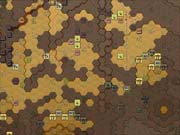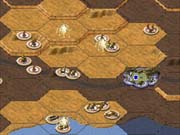Middle East Conflict 1948-1973 is a wargame that stands out for both its originality and its relevance. It is the latest entry in a genre that has focused almost exclusively on a few high-profile wars, and it has a sense of immediacy typically missing from wargames. Unfortunately, this doesn't quite sustain what is otherwise a relatively limp adaptation of TalonSoft's wargaming engine.

Most wargames visit World War II or the American Civil War. But Divided Ground centers on the brief flurries of combat between Israel and its Arab neighbors. These battles have made guest appearances in other games (there were a few scenarios in TalonSoft's 1998 Operational Art of War), but until now, they've never had a starring role in their own game. This is partly because the Arab-Israeli conflict is small potatoes compared with the usual fare in wargames. But while these may be relatively minor chapters in the history of warfare, the tensions that fueled them are still in effect. In fact, with the situation in Israel being what it is, Divided Ground has an unsettling real-world significance you don't get when you're replaying Pickett's charge at Gettysburg or the 1944 Omaha Beach landing.
When Israel announced its statehood in 1948, it fought back local Arabs to carve out a slice of territory in Palestine. In 1956, the Israelis crossed the Suez Canal and seized the Sinai Peninsula from Egypt. In 1967, Israel initiated the Six Day War when it launched a brilliantly executed preemptive strike against Egypt, Syria, and Jordan, which were plotting their own attacks. And finally, in 1973, the same three Arab nations were joined by Iraq for a surprise attack against Israel during the religious holiday of Yom Kippur. The attack was handily repulsed, and the war was over in three weeks.
Divided Ground is a collection of scenarios from these four instances of the Arab-Israeli conflict. You can play the scenarios singly or as part of a campaign of linked scenarios in which casualties carry over from battle to battle. You can play as either side in a campaign covering Jordan and Israel fighting on the West Bank in 1967 or in a campaign covering Syria and Israel fighting over the Golan Heights in 1973. The maps tend to be in the 10km-by-10km range, and the battles represent an hour or two of fighting, divided into six-minute turns. The scenarios are played on a tactical scale, with each unit's strength points representing individual vehicles or squads of soldiers. Each unit uses action points to move, fire, and return opportunity fire during the opponent's turn.

Divided Ground uses the same engine from TalonSoft's East Front, West Front, and Rising Sun games, collectively called the Campaign Series. But unlike the fairly extensive updates we've seen in each of those successive titles, there's very little that's new in Divided Ground. This is particularly disappointing--after all, Rising Sun had brought to life the unique aspects of ground combat in the Pacific Theater of World War II. There were new rules for night combat, entrenched positions, and the almost indomitable spirit of Japanese infantry. But Divided Ground has only a few new features that amount to small twists.
For instance, some of the later scenarios successfully convey a sense that the face of war is changing. Historically, tank battles have revolved around ballistics factors such as armor penetration and range. But with increasingly lethal weaponry, modern warfare has shifted to a game of detection. If you can see it, it's dead. Divided Ground introduces the early days of this shift with antitank guided missiles (ATGMs) such as the TOW and AT-3 Sagger. With these tank killers, armor is suddenly frail, and range isn't as important a factor as line of sight.
Similarly, some of the later scenarios portray the introduction of helicopters. However, these aren't the deadly gunships that prowl today's battlefields. Early on, helicopters were mainly airborne troop transports that afforded infantry unprecedented mobility. With helicopters, you can quickly waltz right over an otherwise invulnerable line of defenders. New antiair units are provided to trump the helicopters.
However, ATGMs and helicopters are a minor part of Divided Ground. Most of the game plays like World War II on a desert palette. This isn't necessarily inaccurate, but there's little sign of the effort that went into making Rising Sun, the previous game in the series, look and feel like a new game in a new place. Part of the problem is that the actual battles are the least interesting part of the situation in the Middle East. Whether it's 1948 or 1973, the pattern is consistent--the Israeli Defense Force marshals its superior training and equipment and beats up on surprised Arab armies. It doesn't make for a very compelling wargame, and it doesn't accurately reflect the complexity of the situation (for a far more interesting take on events, you'll have to revisit SSI's 1992 port of the board game Line in the Sand, which is all about the delicate, shifting geopolitical balance in the Middle East).

But having said that, Divided Ground does what it can to make an interesting wargame out of a lopsided situation. There were some significant military moments in these wars, and you'll find some of them here. There's the triumphant taking of Jerusalem in 1948. There's the bloody fighting against Syria in the hotly contested rough terrain of the Golan Heights. There is Israel's opening move in Gaza at the start of the Six Day War. One of the most fascinating scenarios details current Prime Minister Ariel Sharon's insubordinate attack on Mitla Pass in the 1956 campaign in Sinai.
Most of the scenarios are played from the Israeli side. To temper Israel's military advantage, a lot of them rely on cheap handicapping tricks, like limited visibility or narrow time limits. One epic battle to root Syrians out of the Golan Heights plays like a frustrating puzzle mission in which you have to navigate a maze of minefields and hard-to-see escarpments. It's like a guessing game--"Is that an embankment or an escarpment?"--in which you try to guess which hex sides a tank can drive over. And there are some scenarios that feel like filler. Who wants to mop up a force of Palestinian militia hunkered down in a coastal town? Who wants to control a group of disorganized Egyptians behind some hastily erected defenses?
One of the most puzzling missions is a nighttime Egyptian commando raid--here, the minimum range of the commando's weapons is three hexes, but the maximum visibility is two hexes. The result is a bunch of troops traipsing around on the beach with absolutely no way to shoot at anything. Were the Egyptians really that incompetent, or did someone at TalonSoft just forget to play-test the scenario? Unlike in the rest of the games in the series, there's a conspicuous shortage of hypothetical scenarios, as well as scenarios balanced for two humans to play against each other. Likewise, the random mission generator and dynamic campaigns that gave Rising Sun almost unlimited hard-drive life are each notably absent from Divided Ground.

The manual is abysmal beyond belief--important information is instead shoved onto PDFs and help files on the CD. Because the Middle East is so brown, the graphics in the 3D view are pretty muddled. And for some reason, Divided Ground won't save its display settings. The engine still doesn't play nice with Windows, bleeding into your desktop colors if you Alt+Tab out of the program. In some scenarios, the AI is horribly scripted. You can watch units dither back and forth, eating up CPU cycles for no apparent reason. Plus, the computer will dribble its forces piecemeal into killing zones. Sometimes it will simply march units in the wrong direction like a quarterback running toward the wrong end zone.
In the end, problems like these manage to unseat TalonSoft's admirable intentions to address a chapter of war seldom visited, but with an unsettling relevance to current events. The Campaign engine has been around far too long to be simply rehashed with so few changes. More importantly, it's sad to see some of the engine's same old problems still in effect. If you're desperate for a wargame that covers the Arab-Israeli wars, you don't have any place else to go. But if you're just looking for a solidly built wargame, your best bet is to stick with Rising Sun for the time being.